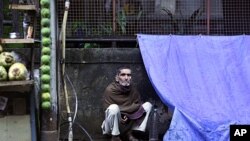In India, norms set by the country’s main planning body to calculate poverty have been slammed by critics who fear they will exclude vast numbers of the needy from social welfare programs. About one third of India’s 1.2 billion population is poor, according to official estimates.
Hari Singh earns about $150 a month working as a security guard in the business hub of Gurgaon near Delhi. After paying $40 to rent a small room in a slum, the 45-year-old can barely manage to buy enough food for the house.
Singh says fruit and milk are out of his reach. He estimates he needs double his income to cover basic expenses on housing, health care and schooling for his son.
But Hari Singh will not be counted among India’s poor, according to new criteria proposed by the planning commission to determine the poverty line.
The planning commission has told India’s supreme court that a person who spends roughly half a dollar a day on food, education and health in rural areas, or $15 a month, will not be considered poor. The bar for the poverty line for urban areas is slightly higher - 66 cents or about $20 a month. The figures are far below the World Bank’s international poverty standard of $1.25 per day.
The planning commission, which guides economic policy, formulated the norms after the country’s top court asked it to explain the basis for its poverty numbers.
The new criteria follow a contentious debate, in recent years, on how to identify India’s poor. After being determined for decades by a person’s calorie intake, it has now moved to income.
But activists and many economists have slammed the new norms for being unrealistic. They say that in a city such as New Delhi, 66 cents would buy a person no more than an onion, a potato, some rice, a banana, a pencil, an aspirin and a bus ticket.
"It’s been understood for some time that this poverty basket is very restrictive. But what is new and I think completely startling is the claim that this poverty line actually ensures adequate expenditure on food, health and education. That really cannot be justified from a common sense point of view… This is more like a starvation line than a poverty line," said Jean Dreze, a prominent development economist involved in India’s economic policy making.
The planning commission says it has to set the poverty line to target those who are most in need. Officials stress that the government must make the best use of limited funds it has to spend on social welfare programs and they cannot cast the net too wide.
Despite India’s spectacular economic growth, millions of people are still poor. The Congress-led government has ambitious plans to cut poverty by spending billions of dollars on employment, health care and education programs. It proposes to pass a law to give cheap food grains to the poor. It wants to replace subsidized fuel and fertilizer with cash transfers.
But activists argue that the government is trying to reduce its welfare burden by reducing the number of those who will qualify for state benefits. Among the critics is Biraj Patnaik, adviser to an official commission on the right to food.
"What they want to do is to exclude 70 percent of the people of this country from any benefit that anti-poverty programs are giving, and this will then subsequently lead to a decline in subsidies… But this is eliminating the poor by deceit, by default and not by improving their lives," said Patnaik.
About 32 percent of India’s 1.2 billion people, or roughly 400 million people, live in poverty, according to official estimates.
But several economists argue that these figures do not accurately reflect the extent of deprivation in a country where nearly half the children under five are malnourished.
A government appointed watchdog, the National Advisory Council, has been arguing that social support should now be extended to all citizens because the country can afford it.
Economist Dreze, who was a member of the council, supports this. He says some states in the country, like Tamil Nadu in the south and Himachal Pradesh in the north, are showing the way.
“We can have comprehensive social security systems and many states in India are actually moving in that direction, expanding the public distribution system and I think the experience of that is reasonably positive that when more people are involved in the system, it works much better. A lot of people have a stake in it. When you have social services restricted to this minority of extremely poor households, it does not work very well, nobody cares," said Dreze.
Among those who agree with the proposal to expand benefits is security guard Hari Singh.
He says, however the official norms define poverty, he counts himself among the country’s poor and would appreciate a helping hand from the government.
India’s New Poverty Definition Upsets Activists, Some Economists










